Jack Linker – FX Through and Through
Posted by Colin Lambert. Last updated: January 20, 2025
Jack Linker is celebrating 50 years in the FX industry, a period that has seen tremendous change. Colin Lambert sat down with him to reflect on the half century
From voice broking, through a hybrid sales/broking role, to fully-engaged with the e-FX business, Jack Linker has seen it all, but his first memory of what would be his working life came even earlier than January 1975, and highlights his encyclopaedic memory; “My Dad used to call a five-dollar bill a pound note, because that was the exchange rate for much of my early life – 5-1,” he observes.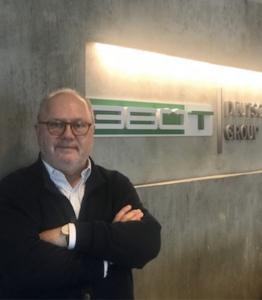
By the time he moved into the FX business properly, fixed exchange rates were a thing of the past but Linker is not just someone who has worked in the foreign exchange industry for half a century – talk to him for any length of time and you realise he an FX historian as well – deliberately or otherwise! This is highlighted when I walked into 360T’s office in Manhattan to find him sitting in a room surrounded by what used to pass for technology, and a host of books and photos from long ago.
The technology is a rectangular, leather trimmed, block with some buttons on it and, to those whose memory goes far enough back, some long-forgotten names from the FX market: Irving, FNCB, Security, Morgan, CIC, BBI (kudos to the first person to correctly and accurately name all six), as well as more the familiar UBS, Lloyds and Montreal. The block is, of course, a rudimentary broker’s phone system, connected the voice broker with multiple banks, but that belies the more complex nature of being a broker in the early post-Bretton Woods, days.
The phone system is, Linker informs me, “post-war” and was used by Lasser Brothers’ brokers to facilitate transactions. “They weren’t brokers in the sense that we now know them,” he reflects, highlighting his historian bent. “And these phones replaced runners, people who would literally run around the different banks with orders written on paper to see if they could get a match. If they did, they would run back to the office and the deal would be agreed and registered.”
The FX industry was clearly intent on reducing latency even back then, because the phone block disrupted the model and very soon brokers were simply getting onto the other lines looking for a match. “I remember when I joined there was a guy in the corner just drinking coffee,” Linker recalls. “He was an old runner still under contract, so he showed up every day and clearly didn’t want to take the next step in broking!”
Within the first year, the old blocks were replaced as broking firms led the way in market structure innovation, a path that was to lead to the famous photo of the London broking desk swamped with phones and cables – a photo that Linker, naturally, has a copy of (see below). 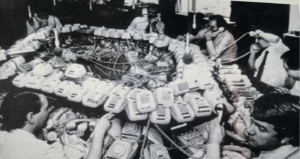
For those in the industry today that feel the regulatory burden, especially on dealing desks restricted by capital and credit bottlenecks, there may be some comfort in the knowledge that such obstacles have always existed. “When I first started at Lassers, I was on the FX swaps desk and there was no international broking, we were only allowed to match domestic banks,” Linker explains. “So my first job was to keep the board updated with the latest prices and stand in the corner with something called an AT&T Call Director, which was basically a house phone with several lines attached and a 20-foot cord.
“We had different colours for different currency pairs and down the whole curve and when there enough changes, I would get on the Call Director and tell all the regionals – and we didn’t have a speed dialler!”
For those familiar with the broking business this was an early form of what is known as the “link” broker – someone who connects the main broking desk with those banks not on the board – and indeed after a year or two Linker moved to become a formal link man once international broking was permitted in the late 1970s. “I shifted from domestic link man to international” he observes with a smile. “I was still on the board and Call Director, but it broadened my horizons.”
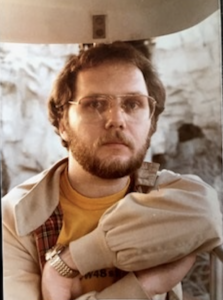
A young – and bagel-free – Jack Linker
As anyone who has met him can tell you, Jack Linker is a people-person – he remembers names from 50 years ago, both brokers and dealers – and he has a natural interest in the wider world. This made him a natural fit for the new form of “link man” when Lassers started connecting to brokers in other centres. “I was talking to Marshalls in London, Hatori in Tokyo, brokers in Paris and Singapore, which meant I got to know a lot of offshore brokers,” he recalls. “You got to know where they were from, and pick out different accents and place them, and, of course, when something big was happening, these brokers would all stick around – it was quite a job.”
Being the link broker did come with challenges, however, in the form of various forms of confectionary, thanks to a practice known as “arm-pitting” on broking desks. “Our New York brokers had a price and they wanted ‘double-bubble’ – the brokerage from both sides, so they didn’t want to give me the price,” Linker explains. “I was always the last port of call, but if I heard the price, I would call it down the link lines and be thanked with a bagel or donut thrown at my head!
“Eventually it become so bad that they put a plexiglass screen behind me, because the interest rate desk behind me was tired of random bagels hitting them when they missed me,” he adds. “At one stage I even wore a plastic face visor!”
For those who think that the FX market structure is radically different, Linker has a message; it’s quicker, but not a great deal different. “We have last look now and bespoke liquidity pools, but when I was first voice broking, we had a thing called ‘discretion’, which meant that a broker didn’t have to show a price to everyone, especially via the link,” he explains. “There is not a lot of difference – the price was good for some people, different counterparties could get different prices, the real difference is we now do this at millisecond speed across hundreds or thousands of connections.”
Jack Linker - The Profit & Loss FX Hall of Fame
With thanks to Julie Ros, founder of Profit & Loss, click here for the tribute to Jack Linker as he was inaugurated into the Profit & Loss Hall of Fame in 2015.
After 16 years with Lassers, Linker made a move to Tullett & Tokyo, (ironically both firms are now part of the same TP Icap Group), where he spent three years running the forward FX desk before making the first career change, albeit nuanced. He moved to Cantor Fitzgerald in New York to run the FX brokerage business, and had his first real interaction with screen technology.
“We built a forward screen from the firm’s 30-year bond screen, and my marketing pitch was everyone around the world with the screen saw the price, so the discretion was only whether me or one of my team put it on the screen,” he explains. “That meant the trader who gave you the order knew you were showing the price because they could see it on their screen – it was more transparent and built trust.
“It was also great advertising. It took the discretion out of it, and that was the beginning of the hybrid broking model” he adds. “We initially went from having one telex to rows and rows of them because a lot of the banks in London would stick around late for things like money supply, but their local brokers wouldn’t. They could see our prices on the screen and would call us.”
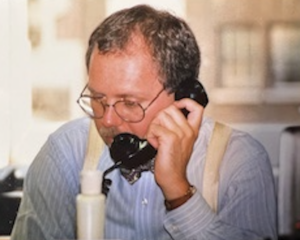
You have to look the part…
Although he wasn’t to know it, one technological change in his time as a broker came from a firm that was to dominate the next stage of Linker’s career – the Reuters Direct Dealer. “That made our job a lot easier and it was so much easier than the Telex,” he observes. “It also allowed us to get more ladies involved in the business – broking was a very male-dominated business, but with brokers using the direct dealer we needed different skill sets.
“At one stage at Lassers, I had a desk of 12-14 and eight were women,” he says. “People asked me why, which reflects the time I guess, but they brought, indeed bring, some great benefits to the business and the desk, and there were none of the so-called problems some were trying to highlight. The industry was moving forward in terms of technology, but also, slowly, in terms of equality.”
Bring on the Tech
It is a cliché in today’s world that automation is mainly about bringing efficiency to manual processes, but there are probably few that experienced what it was like before automation really kicked in – and exactly how much easier the world has become thanks to that – than Jack Linker.
It starts with the real basics. “You want to talk the benefits of automation?” he responds with a laugh to a comment from me. “Brokers would write deals on their pads – as well as the tickets – and they never threw those pads away. They would just put another pad on top every day and eventually the pad could be chest or neck high – it was nuts!
“There was a good reason for it, though, because dealers would sometimes want details of a trade they did months before, or they wanted to query an aspect of the trade, and the broker would just wade back through their wad of sheets until they found the day and the deal,” he continues. “That was effectively today’s trade blotter – it’s easier with a search function!”
There were also the curiosities of the market. “Cable – and later ECU, which was a real nightmare – was quoted in dollar terms in the US, but sterling terms in the UK,” he explains. “Not only that but that meant the prices had to be transposed between the two centres, so the bid became the offer and vice versa. We had to agree with the link at the other broker which way we were going to quote it.
“Some countries, Belgium stands out, had two currencies, so you had a different price for each Belgian franc,” he adds. “And then came the ECU…”
The forerunner of the euro does indeed sound like a nightmare to broke, given it was calculated from eight or more currencies. “I remember EAB New York decided to start quoting the ECU, and that just made the link work even harder. Then there was the changing members of the ECU, it was eight currencies for a while, then 12, and then one or two fell out after September 1992. You had to be on your toes because if you got it wrong as a broker most times you were held to the deal.”
With banks now more attuned, but not totally onboard, with quoting “all-in” prices for FX swaps to take into account cleared/uncleared and other costs on the platforms, it is interesting to hear how there were – again – two markets at any given time in any given currency pair and tenor. “If a bank made you a price on a “coming to me” basis, it was without the brokerage accounted for,” Linker explains. “Equally, it could be a price “to the street”, which meant the dealer had included the bro, so if you hit them, it was, for example, a quarter of a point off their price.”
If you think knowing whether to quote “35-40” or 34 ¾-40 ¼” sounds stressful, in addition to the other requirements of turning the quote around, understanding what centre made it, and who exactly had the price, you’d be right and Linker makes an astute observation when he notes, “The real stress and complications came with the details. Actually doing the deal was the easy part – if you had the details correct.”
Skill Sets
It is fair to say that some brokers did burn out, and Linker looks thoughtful as he recalls some of the people he worked with in the past that are no longer about. He also, however, stresses how grateful he is that the fates provided him with a path into the electronic side of the business, somewhere he could put his people skills and attention to detail to work.
At the start of 2001, he joined Reuters with the task of replicating that firm’s success in the electronic spot market, in the forwards. “Reuters had launched Matching for Forwards but no-one was using it,” Linker recalls. “Spot was on the Dealing screen, but forwards required a separate screen and often wasn’t even turned on! The dealers had it because it didn’t cost them anything to have it there, but they weren’t even looking at it.
“Tom McGowan and I in New York just went around to the banks – which was a revelation to me, because as a broker you never went onto the bank dealing floors, but Reuters had the reputation and the access – and I would walk over to someone, put a hand on their shoulder, and say ‘hey buddy, how about putting a price in there?’”
The growth was nothing like that at the start of the e-spot era with Matching and EBS, but growth there was, thanks largely to the relationships built by Linker and his colleagues, their standing in the market, and their approach, which was more educational than it was sales-focused. The latter was important, of course, ‘once a broker…’ but it was largely about showing the next generation of traders that while the broker could still be of use – Linker observes that in the early days it was still quicker to deal via the broker than on matching for Forwards – the future was electronic, or at the very least both.
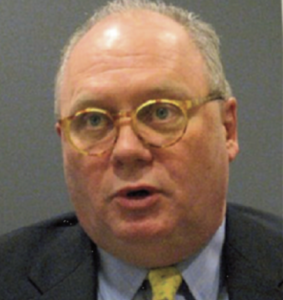
From talking on the phone to talking on panels
With volumes growing on the forwards platform, Reuters extended Linker’s remit to the spot market, something he had not really been involved in previously. “I obviously knew about spot, but it was, is, a different beast,” he observes. “It took some getting used to because the relationships were different. On the forwards I felt we built deeper, longer-lasting relationships because the pace of dealing was slower and the machines took longer to take over.
“I am still talking to people that came in the market shortly after me, because traders in the forwards market tend to be long-stayers, the stress levels are slightly lower,” he continues. “Equally, the spot dealers loved the machines, the forwards took a little longer, which meant you had more time to talk to them.”
One, of many, lovely anecdotes Linker throws in at this stage, is about the time he went into SocGen New York and was mystified by the atmosphere. “I couldn’t hear a broker, all I could hear was ‘click, click, click…,” he says. “The dealers were arbing all day long and what I could here was the tapping of the keyboard at a really fast rate – mainly from Soren Haagensen.
“I had to take the developers in to see him, because he was complaining about a lag after he hit the button, and the tech teams had to make things faster to catch up with the human,” he says with a laugh.
A noticeable aspect of any conversation with Linker is how he recalls so many details, and names, from the past and present. When asked he reels off a dozen names that he thought were great brokers or dealers, and another dozen who had such tremendous mental capacity they could calculate complex forward strips across multiple currencies, come up with a specific price – and execute the deal – in a matter of seconds. “I’m the first to put my hand up and say I didn’t have that mathematical skill,” he stresses. “I could work them out, but it would be slower.
“My skill sets have always revolved around two things, both of which I learned from my dear old dad – be a good listener and be honest with people,” he adds. “That helps you be a good judge of people and helps you build good teams – I am tremendously proud of the teams I helped build, and I am still friendly with all those who worked in them.”
Full Circle
In 2017, the legacy business of Reuters cut resources, and Linker found himself at a crossroads – did he want to add to his 40-plus years in the FX business? Luckily for the industry (and I suspect the business), 360T saw the value he could bring to the platform and hired him in a relationship management role.
That role took him, to a degree, full circle, because 360T was adding, or looking to add, regional banks as takers on the platform. So having started talking to banks around the US, Linker was back talking to them, albeit in a very different language. “You talk more around data and analytics than obviously you used to, but really it’s still about being a facilitator – if a client needs something from 360T, if I can’t deliver it, I can put them in front of someone who hopefully can,” he says.
He is also talking, naturally, to the top tier players, something that was important when 360T took a big step into the forwards market with SUN – something that also took Linker back to his roots. “SUN is a platform that is bringing the big players together,” he explains. “But it is increasingly also attracting regional and specialist banks – it replicates a lot of the broker process, which means they can deal at mid, which is where most banks want to deal.”
This has also allowed Linker to continue, and extend, the thing he values above all else from his 50 years – his circle of friends. “I was so lucky to be able to travel the globe and build so many relationships with some great people,” he says. “In particular to places like London, Mexico City and Tokyo, where I still have so many relationships that I cherish to this day.”
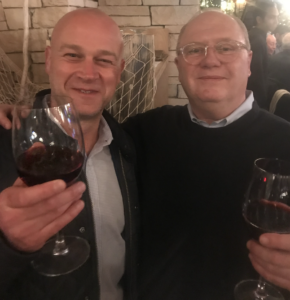
Celebrating with the man Jack Linker terms the author of what “could” be his final chapter of work!
For those lucky enough to spend an hour or more in the company of Jack Linker, the feeling you are left with is having met and spoken someone with a deep and genuine affection for the FX market – and the people in it. It is also an education, thanks to that greatest of broker skills – the memory of an elephant!
Interspersed with serious observations on how the market has changed – and Linker is most definitely not one who believes everything was better in the “old days” – are great little stories about things such as owning cows as a tax break, visits to novelty stores, and the stress-relieving pranks that could be played on each other.
Those stories are for Jack himself to tell you – they are worth it, I guarantee it – but one to close with. Not too many years ago, he found himself sitting at a bathtub in the Savoy Hotel in London with a cigar and a brandy. “I remember feeling like Winston Churchill and thinking to myself, ‘Jack, you’ve made it’” he says with a laugh.
Made it he has – to 50 years in the front line of the business. He is FX through and through.
16 Comments
Comments are closed.
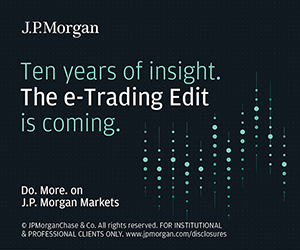

Congrats on 50 years at the front row of the FX business. When I think of pioneers in the global FX business I think of Jack Linker as the leader of the pack. His honesty and integrity have always been hit tools. Best of luck always Jack.
Thank you again Steve for your kind words. Coming from a true legend, they mean so much.
I remember the yen fx swaps screen at cantor very well. It cost me sleepless nights making it and the way the forward points were always quoted as a positive number. Even when they were actually negative.
Happy days long ago.
Thanks, Tim. For your good work and friendship back then. I’m glad we had that time to work together.
I met Jack after he had established himself at Reuters as the leader of FX electronic brokerage. It’s easy to love Jack. Generous with his knowledge, honest and professional, full of integrity. I consider myself lucky to know the man. To THE Link Man, much respect
Thank you very much, Brian. Really appreciate the kind words.
Love this profile and I learned so much!
Thanks you, Marina.
Great story….
Thanks, Jeff.
Thank you Colin and Jack for the fantastic article. Jack needs to write a book.
Thanks, Joe. Much obliged.
Known Jack since 1976. He and his team at Lasser my forward yen brokers for 15 years.
Many great stories. Pontiac Super Bowl.
All the accolades well deserved.
A people person, a survivor, a HOFer.
I call you friend
Thanks for the memories, Bob. I appreciate the kind words, my friend.
Great story…Congratulations Jack!
Jack, thanks very much for the memory and yes it certainly was a big change for people to come onto our FX trading floor, after having been visiting money center banks prior. And to second Stephen Flanagan, then you are certainly a pioneer.